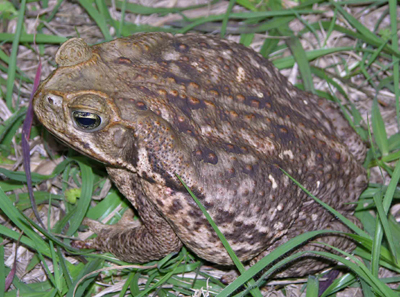Poison Frogs Biology Species
Data: 3.09.2018 / Rating: 4.7 / Views: 810Gallery of Video:
Gallery of Images:
Poison Frogs Biology Species
In the second survey, fewer than ten helminth taxa were identified across the 300 species of poison frogs (Campiao et al. , 2014), compared to the 16 species reported in only two species of temperate frogs, Rana catesbeiana and R. The Santiago poison frog, Adelphobates captivus, a species not seen in life since 1929, was recently rediscovered on an expedition to its type locality in northwestern Peru. The colors of this species, previously unknown, consist of a black dorsum with bright redorange spots and yellow spots ventrally. A bright orange poison dart frog with a unique call has been discovered in Donoso, Panama. Because this new frog species appears to be found in only a very small area, habitat loss and collecting. Ecology links these poison frogs traits together, where predation and spatial structure of the environment has driven the evolution of (and variation within) both chemical defenses and parental behaviors. A recent publication in Biology Letters added a new family, Eleutherodacytlidae, to the list of frogs known to possess defensive, toxic alkaloids in their skinthe socalled poison frogs [[1[1. The alkaloids have attracted much attention since they are not synthesized by frogs de novo. Poison Frog Biology Poison frogs (family Dendrobatidae) represent approximately 160 species and are a conspicuous part of neotropical rainforests. With their bright coloration and intriguing behaviors, they are frequently seen by even casual observers. This bible of Dart Frogs provides practical information on keeping and breeding, most common diseases and their treatment, and important information on all aspects of captive husbandry of the known species and subspecies of poison frogs found in Central and South America. The evolution of coloration and toxicity in the poison frog family (Dendrobatidae) Kyle Summers and Mark E. Clough Department of Biology, East Carolina University, Greenville, NC. The phantasmal poison frog, Epipedobates anthonyi, is the original source of epibatidine, discovered by John Daly in 1974. In fact, epibatidine is named for frogs of this genus. [Aposematic species are usually diurnal, as is the case of most aposematic frog species, including the wellknown toxic poison frogs in the family Dendrobatidae. Dendrobatid frogs are found in Central and South America and represent the most speciesrich group of poison frogs, including more than 90 species in eight genera (Adelphobates, Ameerega, Dendrobates, Epipedobates, Minyobates, Oophaga, Ranitomeya, and Phyllobates; for recent taxonomy, see Grant et al. It consolidates everything that is known about poison frogs. Its comprehensive bibliography demonstrates in an impressive manner just how many treatises on the systematics and biology of the Dendrobatoidea have been published over the past thirty or so years. The poison frogs (family Dendrobatidae) are terrestrial anuran amphibians displaying a wide range of coloration and toxicity. These frogs generally have been considered to be aposematic, but relatively little research has been carried out to test the predictions of this hypothesis. The combination of the poison dart frogs' colouration and diurnal habit reduce the risk of predation on these organisms. Dendrobatids only have very few predators. Several species of snakes in South America are capable of eating these frogs because they are. Poison Frogs: Biology, Species Captive Husbandry [ Stefan Lotters: Stefan Lotters, KarlHeinz Jungfer, Friedrich Wilhelm Henkel: Amazon. mx: Libros A Review of Chemical Defense in Poison Frogs (Dendrobatidae): Ecology, Pharmacokinetics, and Autoresistance Center for Systems Biology, Harvard University, Northwest Labs 359. 30, 52 Oxford Street, Cambridge, , MA USA Dendrobatidae is a monophyletic clade containing more than 300 species. All mem From biology of the poison dart frog to care housing, broad and specific breed information, proper breeding techniques by species and common health issues of species kept in captivity. in Buy Poison Frogs: Biology, Species Captive Husbandry book online at best prices in india on Amazon. Read Poison Frogs: Biology, Species Captive Husbandry book reviews author details and more at Amazon. Free delivery on qualified orders. Biology: Dendrobatids are diurnal frogs and occur in riparian, terrestrial, or semiarboreal microhabitats in tropical forests. All species deposit eggs in terrestrial nests. R1026 Current Biology 25, R1019R1031, November 2, frogs, or just poison frogs? There are three species of poison frog (genus Phyllobates) to which common names including arrow or Provides practical information on keeping and breeding, most common diseases and their treatment, and important information on all aspects of captive husbandry of the known species and subspecies of poison frogs found in Central and South America. Vibrant, colorful, and deadly, poison dart frogs are one of those aweinspiring wonders of the South American rainforest. Defying the general camouflage is great defensive mindset, these unique creatures choose instead to flaunt their aposematic coloration, daring predators to take a bite. The sound belonged to a new species of Poison frogs, also known as poison dart frogs. Predators such as snakes and scorpions, however, use venom, which must enter another animal's body by physical. The species is smaller than other colorful dart frogs present in the area, such as the Strawberry poisondart frog (Oophaga pumilio) and the Vicentes poison frog (Oophaga vicentei). Biology; Ecology; September 12, 2018 But at frog level, we used this approach to find that there are in fact five species of Harlequin poison frogs not two. Book review Herpetological Bulletin [2010 Number 111 43 Poison Frogs: Biology, Species and Captive Husbandry stefan Ltters, KarlHeinz Jungfer. Worksheet Poison Frogs with Dr. Michael HeithausTeacher Notes and AnswersBACKGROUNDIn this video, Mike Heithaus travels to La Selva Biological Research Station inCosta Rica to study the decline of poison dart frog populations. From biology of the poison dart frog to care housing, broad and specific breed information, proper breeding techniques by species and common health issues of species kept in captivity. Provides practical information on keeping and breeding, most common diseases and their treatment, and important information on all aspects of captive husbandry of the known species and subspecies of poison frogs found in Central and South America. Based on several years of fieldwork and current. Poison Frogs by KarlHeinz Jungfer, Friedrich Wilhelm Henkel Stefan Lotters and a great selection of similar Used, New and Collectible Books available now at AbeBooks. Filed Under Animals, Biology, Dark Web, Data Environment. But at frog level, we used this approach to find that there are in fact five species of Harlequin poison frogs not two. From biology of the poison dart frog to care housing, broad and specific breed information, proper breeding techniques by species and common health issues of species kept in captivity. After weighing the frogs, we give each frog acondition scorefrogs that have higher values are healthier and frogs that havelower (negative) scores are sicker. Mike and Steven collected ten individuals of several frog species. Poison frogs: biology, species and captive care. [Frank Mutschmann; et al Introduced Species Summary Project Green and Black Poison Dart Frog or Poison Arrow Frog Biology of Amphibians. The Johns Hopkins University Press, Baltimore and London. Diel activity patterns of the sympatric poison dart frogs, Dendrobates auratus and D. Some species of poison dart frog lay eggs on the forest floor and protect them, guarding the eggs from predation and keeping them moist. The frog will urinate on them if they become too dry. After hatching, a parent (the sex depends upon the species) will move them, on its back, to a waterholding bromeliad. By studying more than 300 dart frogs, the researchers have found that two existing Oophaga frog species actually hid three additional groups, and that there are actually a total of five species. Amphibian Biology and Husbandry resulted in a change of the generic names of many species. The literature of amphibian biology uses the old names, and literature searches require these names. To minimize con dartpoison frogs, Dendrobatidae). Animals called toads are Poison frogs, also commonly called dart poison frogs or poison arrow frogs, are charismatic amphibians forming a spectacular adaptive radiation, comparable to that of African cichlids. Many of the diurnally active species have skin toxins and bright coloration ( Figure 1 Figure 1 ), and display numerous terrestrial reproductive. Poison frogs look after their clutches and deposit the newly hatched tadpoles in bodies of water where they remain until metamorphosis. In some species, [Show full abstract These frogs are known as the jewels of the rainforest, but can cause death or serious discomfort to an unwary victim. Some of the most beautiful things on this planet are also some of the most deadly. Poison frogs occupy various types of habitat. While many species are found in the lowlands ( 300 m), certain species range up to 2000 m or higher. In Peru, most are found in the transition zone, a midelevation area ( m) with many different valleys separated by cordilleras (small mountain ranges). Amphibians globally, including the poison frogs of the Neotropics, are gravely threatened by habitat loss, pollution, invasive species, climate change, and a fungal disease chytridiomycosis, which. introduce the dendrobatids, a charismatic group of frogs known for their colourful and often poisonous skin. Poison frogs: Current Biology Skip to Main Content Poison frogs are commonly called poison arrow and poison dart frogs due to native Indian tribes reportedly rubbing their arrow tips on the frogs' backs before hunting. However, only three species have been documented as actually being used for this purpose, including the golden poison frog, the most toxic of all frog species. Uno de los grandes libros sobre ranas venenosas publicados hasta la fecha, con 668 pginas y ms de 700 fotografas a todo color. Demonstrations of interactions between diverse selective forces on bright coloration in defended species are rare. Recent work has suggested that not only do the bright colours of Neotropical poison frogs serve to deter predators, but they also play a role in sexual selection, with females preferring males similar to themselves.
Related Images:
- David tian the desire system
- THE FORBIDDEN LEGEND SEX CHOPSTICKS
- BROS BEFORE HOS
- Two and half men s09e24
- Noi e la Giulia
- Manual Mantenimiento Toyota Land Cruiser D4D
- Cinema paradiso sub eng
- Translating for Children
- Star war 1 hindi
- Modern family season 4 subtitles
- Young thug mixtape
- Film iron man 3
- Street fighter the ani
- Network hacking tutorials
- Dar es salaam usiku
- 2
- 8 man football
- Green lantern the animated series series 1
- Agilmente Estanislao Bachrach Epub
- Porte aperte ita
- El hombre que vendia tiempo personajes
- Sphinx of the imagination
- Brit chicks 2
- Bbc Sense and Sensibility
- Batman lil gotham
- New english file advanced pdf chomikuj
- Made in dage
- Blonote English Edition
- Bones season 18
- Justice league justice
- Divide by two by francisco arcellana full text
- Confessions of a hollywood starlet
- Nba playoffs 2018 g3
- Design of Machine Tools
- Prince of persia pc
- The proclaimers flac
- Santas hottest helper
- Card Captor Sakura
- Black mommas 2
- Krishnamurti Kundli
- Kaleidoscope City A Year in Varanasi
- Demi lovato
- Best hd songs
- Halfway to heaven brantley gilbert
- Saw 1080p Yify
- Graphic patch pes
- Amharic Love Books Pdf
- Raft Wars 2 Hacked Unblocked At School
- Mission istaanbul 2018
- The Usual Suspects sub
- Win 7 ultimate 64 bit activation
- Applied Ict As A Level Edexcel
- Die Besten Wortwitze Der Welt
- The divide ettv
- Marathi movie mp3
- Alan jackson christmas
- Supernatural s01 all
- Teenies Zart Und Hart
- Ba pass full movie download in 3gp
- Martin Malcolm America A Dream Or A Nightmare
- Rio 1 1080p
- Se ela soubesse
- Think tank comic
- Nero for windows 8
- Colbert report 2018 10
- The proclaimers flac
- Art of fighting 2018
- The midnight meet train
- Race against machine
- Jack ryan nl brrip
- Cio email list xls
- RG Mechanics splinter cell
- Mission impossible saga
- New adventures of old christine season 4
- Manual Maquina De Coser Singer Super Punto 14
- Angel warrior 2018
- Yify stephen king
- Person of interest season 1
- Slam it Young Pussy
- Human contract 1080












